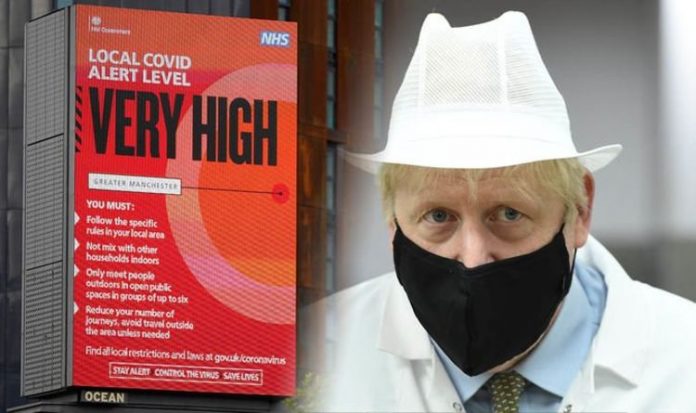Tier 3 rules will soon be in effect across seven percent of England after the classification was extended to new areas in the country this week. Tier 3 lockdown areas are areas with “very high” levels of coronavirus infection and therefore involve the strictest measures. Express.co.uk has compiled a map to show which areas are now in Tier 3.
What is the three-tier system?
The Government’s traffic light system sees parts of the country categorised depending on their rates of infection.
Local lockdown classifications are determined by the three-tier system.
Tier 1 is the medium level which covers most of the country and consists of the current national rules including the rule of six and the closure of hospitality businesses at 10pm.
Tier 2 is the high level which covers many areas under local restrictions and prevents people from mixing with other households indoors and also mandates the rule of six.
Tier 3 is the very high level where transmission rates of the virus are at the highest levels causing the most concern.
READ MORE: Tier 4 lockdown: Will Tier 4 lockdown be introduced?
What are the current infection rates in each of these Tier 3 areas?
The Tier 3 regions have the following number of cases and infection rates per 100,000 people:
- Liverpool: 2,722 cases – 546.5 per 100,000
- Barnsley: 1,336 cases – 541.2 per 100,000
- Doncaster: 1,501 cases – 481.3 per 100,000
- Rotherham: 1,230 cases – 463.4 per 100,000
- Sheffield: 2,726 cases – 466.1 per 100,000
- City of Manchester: 2,690 cases – 486.6 per 100,000
- Trafford: 947 cases – 399 per 100,000
- Bolton: 1,520 cases – 528.6 per 100,000
- Bury: 982 cases – 514.2 per 100,000
- Tameside: 1,007 cases – 444.6 per 100,000
- Rochdale: 1,280 cases – 575.5 per 100,000
- Salford: 1,483 cases – 573 per 100,000
- Oldham: 1,413 cases – 595.9 per 100,000
- Stockport: 1,056 cases – 359.9 per 100,000
- Wigan: 1,882 cases – 572.6 per 100,000
- Liverpool: 2,722 cases – 546.5 per 100,000
- Knowsley: 932 cases – 617.8 per 100,000
- Wirral: 973 cases – 300.3 per 100,000
- St Helens: 849 cases – 470.1 per 100,000
- Sefton: 1,238 cases – 447.9 per 100,000
- Halton: 444 cases – 343.1 per 100,000
- Lancaster: 594 cases – 406.7 per 100,000
- Wyre: 424 cases – 378.3 per 100,000
- Ribble Valley: 315 cases – 517.3 per 100,000
- Pendle: 468 cases – 508.1 per 100,000
- Blackpool: 675 cases – 484.1 per 100,000
- Preston: 670 cases – 468.1 per 100,000
- Hyndburn: 377 cases – 465.2 per 100,000
- Fylde: 286 cases – 354 per 100,000
- South Ribble: 479 cases – 432.4 per 100,000
- Chorley: 459 cases – 388.3 per 100,000
- West Lancashire: 531 cases – 464.5 per 100,000
- Blackburn with Darwen: 1,102 cases – 736.2 per 100,000
- Rossendale: 461 cases – 644.9 per 100,000
- Burnley: 415 cases – 466.7 per 100,000
- Warrington: 795 cases – 378.5 per 100,000
- Nottingham City: 1,643 cases – 493.5 per 100,000
- Broxtowe: 410 cases – 359.5 per 100,000
- Gedling: 483 cases – 409.7 per 100,000
- Rushcliffe: 453 cases – 380.1 per 100,000
What happens in Tier 1 and Tier 2?
Tier 2 areas include London, Derbyshire, West Yorkshire, Durham, Northumberland, Tyne and Wear, Tees Valley, West Midlands, and Leicestershire.
In these areas, households cannot mix indoors and the rule of six applies to outdoor settings.
Shops, gyms, all education settings, and places of worship can remain open and overnight stays permitted.
You are permitted to have up to 15 guests at weddings and up to 30 people allowed at funerals, with 15 allowed at receptions and wakes.
In Tier 1 areas, restrictions include the 10pm curfew for pubs and restaurants and a ban on most gatherings of more than six people.
Similar to Tier 2, up to 15 guests are allowed at weddings and up to 30 people allowed at funerals, with 15 allowed at receptions and wakes.







